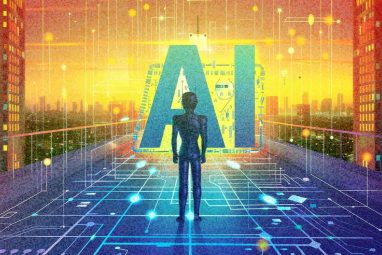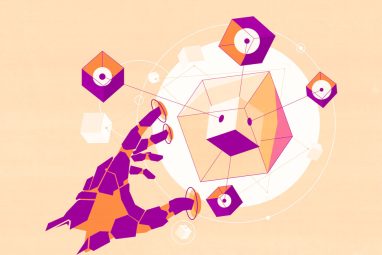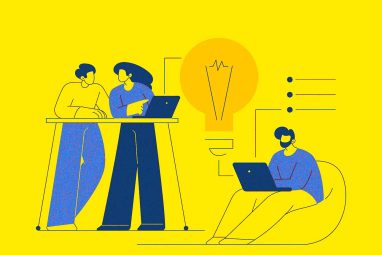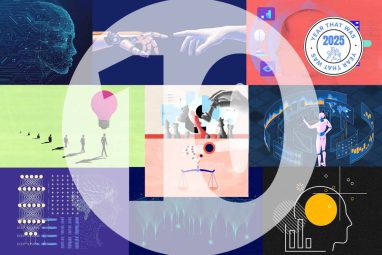How GenAI Changes Creative Work
Artificial intelligence is reshaping creative work and its teams. Leaders must prepare to address these ongoing shifts.
News
- NVIDIA Deepens AI Push With $5 Bn Intel Stake, $20 Bn Groq Deal
- What VCs Expect from Enterprise AI in 2026
- Manus Joins Meta in Major Bet on Autonomous AI Agents
- AI Job Losses Could Accelerate By 2026, Geoffrey Hinton Warns
- Bahrain Shows High Digital Maturity in World Bank GovTech Index
- Sam Altman Calls for a Head of Preparedness at OpenAI
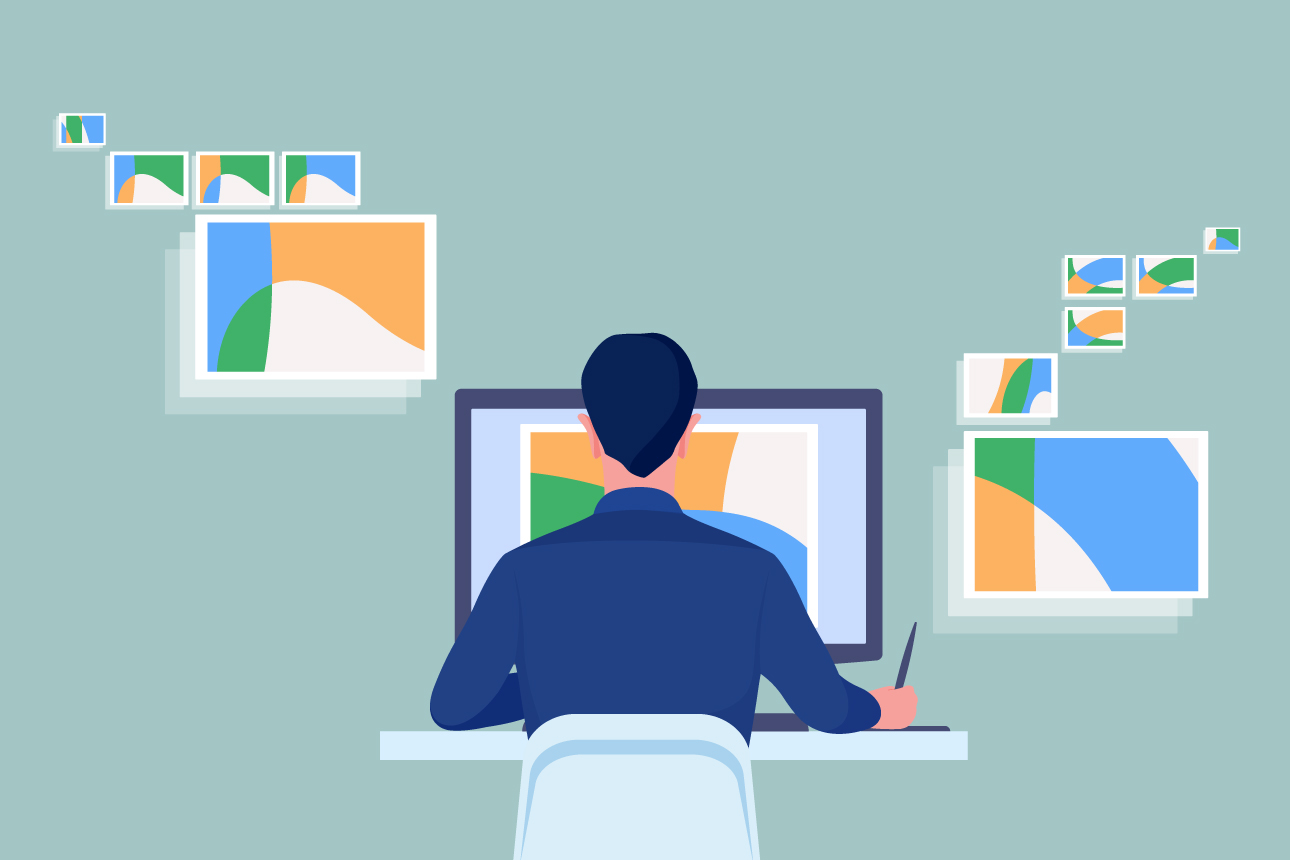
Carolyn Geason-Beissel/MIT SMR | Getty Images
Can AI be creative? While this question often leads to philosophical debates about the meaning of creativity, one fact is clear: Many creative professionals are already using an increasing array of AI tools.1 Art directors, copywriters, and others are harnessing generative AI’s capabilities to generate a large stream of text, imagery, and sound on demand. In one notable example, AI-generated content was selected as the winner in the creative photo category of the Sony World Photography Awards.2
What does this trend mean for the future of creative industries, the leaders who manage creative work in their companies, and their coworkers who make decisions in related areas such as marketing, sales, and legal? Here, we’ll discuss the ways in which AI is affecting this type of work and how creative leaders and their colleagues can prepare for these shifts.
Four Areas Where GenAI Disrupts Creative Work
Through our research and work with companies in this realm, we’ve identified four key changes that are reshaping the nature of creative work in the age of artificial intelligence.
1. Creative Content Supply
The proliferation of generative AI tools is set to substantially increase the creative content supply by enabling high-speed, low-cost production work. Consider the results of a survey of 650 executives: Early adopters of GenAI saved about 11 hours per week in various content marketing tasks, such as brainstorming and refining the design of images, infographics, and other visuals.3 Likewise, creatives are using generative AI to rapidly prototype ideas and test them within minutes.4
One concern is that the AI-enabled surge of creative content comes at the expense of quality. Indeed, there are cases of low-quality or even fraudulent AI-generated content, such as the “copycat” books that already populate Amazon.5 But there is also evidence that AI can provide help, especially for people who lack skills or confidence. For example, a recent study showed that generative AI increased writers’ creativity, with the most pronounced improvements — up to 26% — seen among less-creative ones.6 Overall, while generative AI will significantly increase the quantity of creative content, its effect on quality will be more complex. This impact will hinge on various factors, ranging from AI capabilities and creator choices to incentives and standards that shape human creativity.
2. Creative Teams
AI-powered tools for language, audio, and visual imagery are enabling smaller teams to achieve more with less. This is not being driven only by efficiency gains. These tools augment individual capabilities and bridge skill gaps, reducing the need to have larger teams to achieve sophisticated creative output objectives.
Consider tools like Udio or Suno AI, which allow creators to generate music for podcasts and ads — tasks that previously required specialized teams or external agencies — in just seconds. Similarly, AI tools like Synthesia enable users to turn text into studio-quality videos with avatars and voiceover options in more than 140 languages, streamlining a process that once demanded large teams.
3. Creative Output Diversity
One important concern about GenAI in creative industries is that it may reduce the diversity in creative output. Consider the findings of a recent study in the context of story writing: Even though generative AI boosted individual creativity, it actually reduced the variety of stories produced.7 This suggests that GenAI may have a homogenizing effect on creative domains.
Such a reduction in output diversity is not inevitable, though. It depends on how these tools are used. For example, a recent study found that using specific prompting techniques, like chain of thought, can generate ideas as diverse as those from humans.8 In addition, if creators maintain their autonomy and voice in AI interactions, the homogenization impact of the technology could be counteracted.
4. Creative Output Fluidity
GenAI enables creative content to adapt in real time based on user inputs and feedback, transforming static content into dynamic experiences that vary from one user to another. This is not just speculation. Consider the Cadbury campaign in India, which used AI and machine learning models to create 130,000 personalized ads featuring Bollywood star Shah Rukh Khan.9 The ads were adapted to the viewer’s location in real time, with the star mentioning nearby stores where they could shop during Diwali.
In some cases, creating highly tailored content does not require substantial data. For example, Carvana, an online used-car platform, used basic data, like a car’s model and location, to generate over a million personalized AI-driven videos, each portraying a unique customer story of how they had found their ideal car.10 These examples point to a future where creative content increasingly evolves into fluid, dynamic experiences.
How Leaders Can Navigate the Future of Creative Work
We recommend that managers and professionals in creative industries, as well as their coworkers, take a proactive stance to prepare for additional generative AI disruption by taking the following actions.
Invest in learning, reskilling, and upskilling. Creative professionals need to acquire AI literacy and learn how to use generative AI tools effectively. Given the rapid development of new options, this is not a one-off exercise but a continuous learning process. Think of art directors who first learned Photoshop several decades ago but kept updating their knowledge and learning more Adobe programs and are now using the products’ new AI tools. But it is important not to just focus on mastering specific applications, given that AI tools change rapidly. Organizations must encourage creative leaders to prioritize transferable and sustainable skills like problem formulation, experimentation, and critical judgment.11
Begin rethinking creative workflows. Generative AI can impact creativity at various stages, from ideation to execution and evaluation. For example, consider the research that has already documented large language models’ striking capabilities in simulating consumer feedback.12 That ability could enable faster and cheaper market research that could inform decisions at different phases of the creative process. The key question for creatives is how to harmonize artificial and human insights for optimal creative outcomes.
Develop bespoke AI solutions that can augment creative staff members’ potential, where there are opportunities to do so. For example, Publicis Groupe, a global marketing and communications company, has built CoreAI, an intelligent system that leverages its proprietary data on 2.3 billion consumers and trillions of content and media data points to offer AI capabilities across the company’s services.13
Recognize that creating new AI solutions for creative tasks does not have to be a costly endeavor. In fact, it might be wiser for most companies to avoid substantial investments at a time when foundational models are evolving rapidly. There are many accessible and affordable platforms that support the development of custom chatbots for various creative functions. OpenAI’s GPT Store, for example, features hundreds of chatbots, from image generators and logo designers to ideators and concept developers, that can support the creative process.
Examine how to best use generative AI to automate the repetitive and tedious tasks in creative workflows. The aim is to enable professionals to have more time and energy to concentrate on the new and unique aspects of their work. For example, Autodesk uses GenAI in its design software not only to offer design options but also to handle routine tasks.14
Evaluate what elements of creative authorship must remain unchanged, and set the boundaries for AI augmentation. For instance, the European Parliament wants music streaming companies to flag AI-generated songs on their platforms, and to remove such songs when they imitate a human performer’s voice without their permission.15 Likewise, YouTube CEO Neal Mohan recently identified three principles for partnering with musical artists who rely on AI technology. While the principles welcome new forms of creativity, they also focus on protecting artists’ work.16 Creative professionals need to play an active part in the conversation around the principles for AI augmentation that respect the originality, ownership, and authenticity of their work.
Keep tabs on copyright issues related to the company’s use of generative AI. Current legal interpretations suggest that AI-generated content alone lacks copyright protection, but when human creativity combines with AI, the resulting work may qualify for copyright.17 To mitigate risks, leaders should choose partners that proactively address copyright concerns, such as providers offering legal assurances or avoiding contested materials in training their models. For instance, companies like Google, OpenAI, and Anthropic offer indemnification policies — though with varying coverage — while Getty Images and Adobe Firefly train their models using rights-owned or license-free content.
All in all, generative AI will transform how creative work is done, but how it will change will depend, to some extent, on how creative professionals and their colleagues engage with it.
Creators need to rethink their workflows, enhance their AI skills, and explore new possibilities with generative AI tools. Only then can they make a meaningful contribution to establishing ethical and professional standards for this new world. Instead of being a zero-sum game between humans and machines, the future of creativity could be a cooperative effort that continues to expand the frontiers of innovation.
References
1. L. Bourton. “Shades of Intelligence: 83% of Creatives Are Already Using Machine Learning Tools — Is Now the Time to Get on Side With AI?” It’s Nice That, Nov. 15, 2023, www.itsnicethat.com; and K. Whiting, “This Is How AI Is Impacting — and Shaping — the Creative Industries, According to Experts at Davos,” World Economic Forum, Feb. 28, 2024, www.weforum.org.
2. A. Parshall, “How This AI Image Won a Major Photography Competition,” Scientific American, April 21, 2023, www.scientificamerican.com.
3. M. Brinker and J. Kelly, “GenAI Powers Content Marketing Advantage for Early Adopters,” PDF file (New York: Deloitte Digital, October 2023), www.deloittedigital.com.
4. B. Holson, “Looking at AI Art Through the Eyes of a Senior Designer,” MadebyAI.xyz, Feb. 8, 2023, https://madebyai.xyz.
5. K. Knibbs, “Scammy AI-Generated Book Rewrites Are Flooding Amazon,” Wired, Jan. 10, 2024, www.wired.com.
6. A.R. Doshi and O. Hauser, “Generative Artificial Intelligence Enhances Individual Creativity but Reduces the Collective Diversity of Novel Content,” Science Advances 10, No. 28, July 12, 2024.
7. Ibid.
8. L. Meincke, E. Mollick, and C. Terwiesch, “Prompting Diverse Ideas: Increasing AI Idea Variance,” working paper, The Wharton School, University of Pennsylvania, Philadelphia, Jan. 27, 2024.
9. “Ogilvy and Wavemaker: #NotJustACadburyAd and Shah Rukh Khan-My-Ad,” WPP, accessed July 10, 2024, www.wpp.com.
10. E. Andes, “Carvana Creates 1.3M+ Unique AI-Generated Videos for Customers,” Carvana 360 (blog), May 9, 2023, https://blog.carvana.com.
11. O.A. Acar, “AI Prompt Engineering Isn’t the Future,” Harvard Business Review, June 6, 2023, https://hbr.org; and O.A. Acar, “Are Your Students Ready for AI?” Harvard Business Publishing, June 15, 2023, https://hbsp.harvard.edu.
12. J. Brand, A. Israeli, and D. Ngwe, “Using LLMs for Market Research,” working paper 23-062, Harvard Business School, Boston, 2023; and P. Li, N. Castelo, Z. Katona, et al., “Frontiers: Determining the Validity of Large Language Models for Automated Perceptual Analysis,” Marketing Science 43, no. 2 (January 2024): 254-266.
13. “After Another Record Year Ahead of Expectations, Publicis Unveils AI Strategy to Lead Group Into Its Second Century,” Publicis Groupe, Jan. 25, 2024, www.publicisgroupe.com.
14. R. DeFrancesco, “Autodesk Infuses Generative AI Across Its Expansive Product Portfolio,” Forbes, March 28, 2024, www.forbes.com.
15. J. Weatherbed, “Music Streaming Platforms Must Pay Artists More, Says EU,” The Verge, Jan. 17, 2024, www.theverge.com.
16. N. Mohan, “Our Principles for Partnering With the Music Industry on AI Technology,” YouTube (blog), Aug. 21, 2023, https://blog.youtube.
17. W. Wright, “Latest Copyright Ruling Should Give Brands Pause for Thought on AI Creativity,” The Drum, Aug. 25, 2023, www.thedrum.com.




